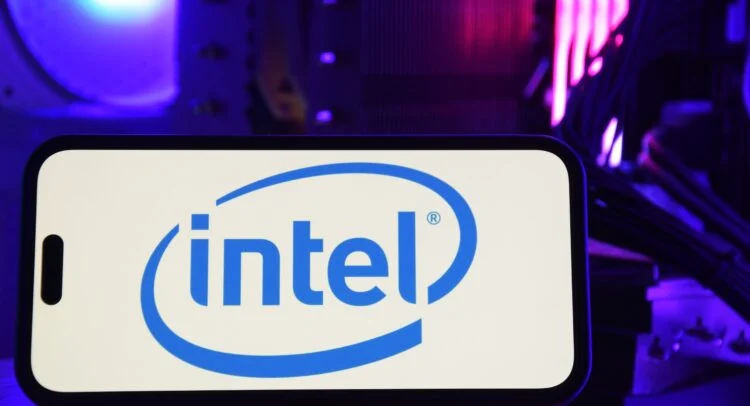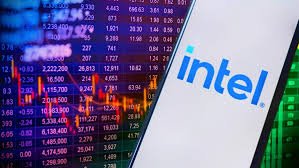1. Company & Stock Snapshot
Intel Corporation (NASDAQ: INTC) is one of the world’s leading semiconductor companies, known for manufacturing CPUs, chipsets, and infrastructure for PCs, data centers, AI, and more. The stock has been under pressure over recent years due to competitiveness, rising costs, and restructuring. But in 2025, key developments are driving renewed attention.
2. Latest Financials – Q2 2025 & Guidance
Here are the most recent financial highlights from Intel’s Q2 2025 and latest outlook:
- Revenue: ~$12.9 billion in Q2 2025, which is flat year-over-year but came in slightly above analyst expectations. MLQ+1
- EPS (Earnings Per Share): GAAP net loss, impacted by one-time charges and restructuring; non-GAAP shows break-even or near zero in certain reports. MLQ+2Investing.com+2
- Q3 2025 Guidance: Revenue expected between $12.6B and $13.6B; gross margin non-GAAP ~36%; earnings outlook reflects losses on a GAAP basis but narrowing on a non-GAAP basis. mint+2Futurum+2

3. Cost Control & Organizational Changes
Intel is making moves to strengthen its balance sheet and reduce costs:
- Lowered its 2025 non-GAAP operating expenses guidance from ~$17.0 billion to ~$16.8 billion, largely due to the sale of the majority stake in its Altera business. Proactiveinvestors NA
- Capital expenditures (CapEx) are being adjusted: target gross CapEx down from around $20B to $18B for 2025; net CapEx in the range of $8-11B expected. Intel Corporation+1
- New leadership (CEO Lip-Bu Tan, appointed in early 2025) is pushing for leaner operations, faster innovation, reduction in bureaucracy. Newsroom
4. Key Catalysts & Risks
What’s driving interest & what to watch out for:
🔑 Catalysts:
- Strategic partnership & investment from Nvidia: Nvidia investing $5 billion in Intel at ~$23.28/share, focused on AI infrastructure and PC chip development. That’s seen as a major positive by analysts. Investopedia+2Barron’s+2
- Government stake: The U.S. government acquired ~10% non-voting stake in Intel, reflecting government support for domestic semiconductor capacity. Barron’s+1
- Exit / deconsolidation of less-core businesses (like Altera stake sale) which helps streamline Intel and free up cash. Proactiveinvestors NA
⚠ Risks:
- Continual losses on a GAAP basis; the non-GAAP break-even is positive but could mask underlying challenges. MLQ+1
- High competition from TSMC, AMD, Nvidia, etc., especially in AI, foundry, and high-performance computing.
- Margins are under pressure — cost of capital, R&D, supply chain, and global dynamics (trade barriers, regulation).
5. Valuation & Share Price Context
- As reported, Intel’s stock price saw a strong jump (~25-30%) following the Nvidia investment announcement. Barron’s+2mint+2
- Price per share in that deal was ~$23.28, which acts as a reference / anchor for short-term valuation moves. Investopedia+1
- Market sentiment is improving due to the positive catalysts, but future returns will be heavily dependent on execution of cost cuts, margin improvement, and successful competition in AI/data center market.

6. Global & Geo-Relevance
- USA: Core operations, government support, and policy impact have strong effects. Investors, analysts in US are closely watching CapEx, margins, and competitive positioning.
- Europe & Asia: Intel’s supply chain and manufacturing footprint (existing and planned) make global market dynamics (tariffs, trade agreements, supply disruptions) very relevant.
- Developing markets: Growth in AI, cloud, and PC demand in Asia, Latin America, etc., can provide demand tailwinds if Intel execution picks up.
7. Outlook & What to Watch (Rest of 2025 and Beyond)
- Can Intel deliver profit (non-GAAP) while maintaining or growing revenue? Margin expansion will be key.
- Execution on manufacturing / foundry efforts — catching up with technology, capacity, and cost efficiency.
- Effects of macroeconomic conditions: chip demand, supply chain, geopolitical tensions.
- Further partnerships / investments, government support, and asset monetization.
✅ Summary & Recommendation
Intel stock (INTC) is in a transitional phase.
If you’re a longer-term investor, the recent investments and strategic moves could mark a turnaround point, provided Intel reduces costs and improves margins. For shorter-term trading, the Nvidia deal and related news offer volatile opportunity. But risks remain high with ongoing losses, competition, and execution needed.
